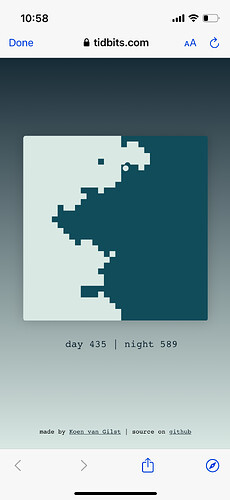Originally published at: Reading Too Much into Pong Wars - TidBITS
This mashup of Pong and Breakout provides a sort of hyperactive digital lava lamp that’s surprisingly mesmerizing.
There are 1024 squares in the grid, not 1000. So the max score would be 1023 since the one losing takes up at least one square.
That’ll teach me to estimate without adding up the values. :-) Fixed…
I played the edited version as mentioned in the last lines. It got stuck very soon, with day and night in an endless embrace.
Hi @ace, as you requested in Mastodon, I have implemented the changes from Keith Dawson in GitHub and created a pull request. there are another nine pull requests pending, so there is no guarantee that they will survive. But at least my branch will have the right code from Keith.
Yeah, I’ve seen it get stuck very quickly sometimes and other times go for hours.
Sometimes it almost feels organic, in the sense of the Game of Life.
Thanks! It looks like there are some interesting proposals in those pull requests.
The first thing I noticed is that they need to add a few things that Atari had decades ago in order to avoid infinite repeating loops.
On games with user-controllable paddles, the ball’s “reflect” angle would not always be a simple 90-degree reflection. Instead, the angle of the ball leaving the paddle would be a function of where on the paddle it hit - closer to the center produce a near-perpendicular angle, while hits close to the edge produce a much wider angle.
Games that involved a “ball” infinitely bouncing would occasionally (maybe once per minute or so) have the software select a random angle after a bounce, in order to ensure it has the potential to go anywhere. (So there is no position of Pong paddles that could result in the ball forever bouncing between them without the players having to move their paddles - so an abandoned game will always end.)
And (as one PR already suggested), the initial angles should be random, not simple 45° paths.
An important thing, given Atari’s and Pong’s coin-op roots!
Reminds me of the steady state that Life often reaches. (Life as in the game that John Conway devised)
I modified it into a version I call “Tag-Team Pong Wars”. When the balls collide, they change colors. It’s at Tag-Team Pong Wars.
It works but could use some fine-tuning. Right now, the balls move sequentially through the list of colors. I want to make the next color random. The balls can still get locked into an endless loop but I think the random colors might fix that. But I’ve already spent a couple hours on this and I need to start doing my real job!
I saw them on top of each other, thrashing colors for an extended period of time (a minute or so), but they eventually broke free of each other.
That makes sense. There is a little bit of randomness added with every iteration.
Ok, I couldn’t help myself! I added the random colors. And I shortened the color names so they won’t word-wrap when the canvas is displayed at its maximum width. I really need to get to work now.
The new version is at the same link.
